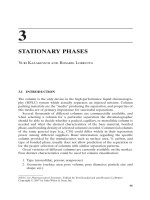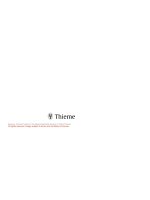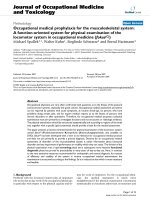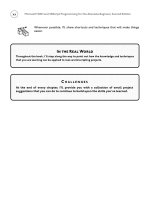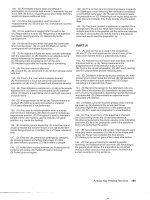Clinical Tests for the Musculoskeletal System - part 3 docx
Bạn đang xem bản rút gọn của tài liệu. Xem và tải ngay bản đầy đủ của tài liệu tại đây (831.13 KB, 31 trang )
Assessment:
This maneuver moves the femoral head into the anterior
part of the joint capsule of the hip. Pain within the hip suggests deg en-
erative joint disease, hip dysplasia, or contracture of the iliopsoas. Pain
felt posteriorly in the sacroiliac joint suggests a disease process at that
site.
Sacroiliac Stress Test
Demonstrates involvement of the anterior sacroiliac ligaments in a
sacroiliac joint syndrome.
Procedure:
The patient is supine. The examiner exerts anterior pres-
sure on the iliac wings with both hands. By crossing his or her hands, the
examiner adds a lateral force vector to the compression. The antero-
posterior direction of the compressive load on the pelvis places stress on
the posterior por tions of the sacroiliac joint, whereas the lateral com-
ponent places stress on the anterior sacroiliac ligaments.
Assessment:
Deep pain is a sign of strained anterior sacroiliac liga-
ments on the side of the pain (sacrospinal and sacrotuberal ligaments).
Pain in the buttocks can be produced by compression from the examin-
ing table or by irritation of the posterior portions of the sacroiliac joint.
Determining the precise location of the pain helps to identify i ts cause.
Spine 45
Fig.
48
Laguerre test
Buckup, Clinical Tests for the Musculoskeletal System © 2004 Thieme
All rights reserved. Usage subject to terms and conditions of license.
Abduction Stress Test
Indicates a sacroiliac joint syndrome.
Procedure:
The patient is in a lateral position. With the leg in contact
with the table flexed, the patient attempts to continue to abduct the
upper extende d leg against the examiner’s resistance. This test is nor-
mally performed to evaluate insuf• ciency of the gluteus medius and
gluteus m inimus.
Assessment:
Increasing pain in the affected sacroiliac joint is a sign of
sacroiliac irritation. Patients with hip disorders may also feel increased
pain when this test is performed. The location of the pain is suggestive
of the type of disorder. If the patient is unable to abduct the leg or can
only do so slightly, but does not report any pain, this suggests insuf• -
ciency of the gluteus medius.
˾
Nerve Root Compression Syndrome
Disk extrusions usually lead to muscular compression syndromes with
radicular pain. The pain in the sacrum and leg is often exacerbated by
coughing, sneezing, pushing, or even simply walking. Mobility in the
spine is severely limited, and there is significant tension in the lumbar
46 Spine
Fig.
49
Sacroiliac stress test Fig.
50
Abduction stress test
Buckup, Clinical Tests for the Musculoskeletal System © 2004 Thieme
All rights reserved. Usage subject to terms and conditions of license.
Abduction Stress Test
Indicates a sacroiliac joint syndrome.
Procedure:
The patient is in a lateral position. With the leg in contact
with the table flexed, the patient attempts to continue to abduct the
upper extende d leg against the examiner’s resistance. This test is nor-
mally performed to evaluate insuf• ciency of the gluteus medius and
gluteus m inimus.
Assessment:
Increasing pain in the affected sacroiliac joint is a sign of
sacroiliac irritation. Patients with hip disorders may also feel increased
pain when this test is performed. The location of the pain is suggestive
of the type of disorder. If the patient is unable to abduct the leg or can
only do so slightly, but does not report any pain, this suggests insuf• -
ciency of the gluteus medius.
˾
Nerve Root Compression Syndrome
Disk extrusions usually lead to muscular compression syndromes with
radicular pain. The pain in the sacrum and leg is often exacerbated by
coughing, sneezing, pushing, or even simply walking. Mobility in the
spine is severely limited, and there is significant tension in the lumbar
46 Spine
Fig.
49
Sacroiliac stress test Fig.
50
Abduction stress test
Buckup, Clinical Tests for the Musculoskeletal System © 2004 Thieme
All rights reserved. Usage subject to terms and conditions of license.
musculature. Sensory deficits and impaired reflexes are additional
symptoms that occur with nerve root compression.
Often the affected nerve root can be identified by the description of
the paresthesia and radiating pain in the dermatome. Extrusions of the
fourth and fifth lumbar disks are especially common, extrusions of the
third lumbar disk less so. Disk extrusions involving the first and second
lumbar disks are rare.
The Lasègue sign is usually positive (often even at 20°–30°) in com-
pression of the L5–S1 nerve root (typical sciatica). In these cases, even
passively raising the normal leg will often elicit or exacerbate pain in the
lower back and the affected leg (contralateral Lasègue sign). In nerve
root compression synd romes from L1 through L4 with involvement of
the femoral nerve, the Lasègue sign is rarely p ositive and then only
slightly and only when the L4 ner ve root is affected.
When the femoral nerve is irritated, the reverse Lasègue sign and/or
pain from stretching of the femoral nerve can usually be triggered.
Pseudoradicular pain must be distinguished from genuine radicular
pain (sciatica). Pseudoradicular pain is usually less circumscribed than
radicular pain. Facet syndrome (arthritis in the facet joints), sacroiliac
joint syndrome, painful spondylolisthesis, stenosis of the spinal canal,
and postdiskectomy syndrome are clinical pictures that frequently
cause pseudoradicular pain.
Spine 47
a b c
Fig.
51
Dermatomes of the lumbar
and sacral plexuses according to
Herlin. The L
4
dermatome rarely
extends as far as the foot, and the
sole of the foot is rarely supplied in
part by the posterior L
5
root
Buckup, Clinical Tests for the Musculoskeletal System © 2004 Thieme
All rights reserved. Usage subject to terms and conditions of license.
48 Spine
Table
4
Signs of radicular symptoms
Root Dermatome Paralyzed
muscles
Impaired
reflexesPain Sensory deficit
L2
L1–L2
Extrafora-
minal:
L2-L3
Thoracolum-
bar junction,
sacroiliac
joint, groin,
iliac crest,
proximal me-
dial thigh
Groin, proximal
anterior and
medial thigh
Paresis of the
iliopsoas,
quadriceps
femoris, and
adductors
(slight)
Cremaster
and patellar
reflex weak-
ened
L3
L2–L3
Extrafora-
minal:
L3-L4
Upper lum-
bar spine,
anterior
proximal
thigh
From the ante-
rior thigh to the
medial thigh and
distal to the
knee
Paresis of the
iliopsoas,
quadriceps
femoris, and
adductors
(slight)
Absent or
weakened
patellar reflex
L4
L2–L3
Extrafora-
minal:
L3-L4
Lumbar
spine, ante-
rolateral
thigh, hip re-
gion
From the lateral
thigh to the me-
dial lower leg
and margin of
the foot
Paresis of the
quadriceps
femoris and
tibialis ante-
rior ( dif•culty
walking on
heels)
Weakened
patellar reflex
L5
L4–L5
Extrafora-
minal:
L5-S1
Lumbar
spine, poste-
rior thigh,
lateral lower
leg, medial
foot, groin,
hip region
From the lateral
lower leg to the
medial foot
(great toe)
Paresis of the
extensor hal-
lucis longus
and brevis,
extensor dig-
itorum
longus and
brevis (dif•-
culty walking
on heels)
Loss of tibia-
lis posterior
reflex (signif-
icant only
when readily
elicited on
contralateral
side)
S1
L5–S1
Lumbar
spine, poste-
rior thigh,
posterolat-
eral lower
leg, lateral
margin of
foot, sole of
foot, groin,
hip region,
coccyx
Posterior aspect
of the thigh and
lower leg, lateral
margin of the
foot and sole of
the foot (little
toe)
Paresis of the
peroneus
muscles and
triceps surae
(dif•culty
walking on
tiptoes; foot
bends later-
ally)
Weakening
or loss of
Achilles ten-
don reflex
Buckup, Clinical Tests for the Musculoskeletal System © 2004 Thieme
All rights reserved. Usage subject to terms and conditions of license.
Lasègue Sign (Straight Leg Raising Test)
Indicates nerve root irritation.
Procedure:
The examiner slowly raises the patient’s leg (extended at
the knee) until the patient reports pain.
Assessment:
Intense pain in the sacrum and leg suggests nerve root
irritation (disk extrusion or tumor). However, a genuine positive
Lasègue sign is only present where the pain shoots into the leg explo-
sively along a course corresponding to the motor and sensory derma-
tome of the affected nerve root.
The patient often attempts to avoid the pain by lifting the pelvis on
the side being examined.
The ang le ach i e v e d when lifting the leg is estimated in degrees. This
angle gives an indication of severity of the nerve root irritation present.
Sciatica can also be provoked by adducting and internally rotating
the leg with the knee flexed. This test is also described as a Bonnet or
piriformis sign (adduction and internal rotation of the leg stretches the
nerve as it passes through the pi riformis).
Increases in sciatica pain by raising the head (Kernig sign) and/or
passive dorsiflexion of the great toes (Turyn sign) are further signs of
significant sciatic nerve irritation (differential diagnosis should consider
meningitis, subarachnoid hemorrhage, and carcinomatous meningitis).
Sacral or lumbar pain that increases only slowly as the leg is raised or
pain radiating into the posterior thigh is usually attributable to degen-
erative joint disease (facet syndrome), irritation of the pelvic ligaments
Spine 49
Fig.
52
Lasègue sign
Buckup, Clinical Tests for the Musculoskeletal System © 2004 Thieme
All rights reserved. Usage subject to terms and conditions of license.
(tendinitis), or increased tension in the hamstrings (indicated by a soft
endpoint, usually also found on the contralateral side). It is important to
distinguish this “pseudoradicular” pain (pseudo-Lasègue sign) from
genuine sciatica (true Lasègue sign).
It can also be impossible to lift the leg at the hip if the patient
consciously resists this and attempts to press the leg downw ard against
the examiner’s hand. Oc casionally one will encounter this behavior in
experienced patients undergoing examination within the scope of an
expert opinion (see Lasègue test with the patient seated).
Bonnet Sign (Piriformis Sign)
Procedure:
The patient is supine with the leg flexed at the h ip and
knee. The examiner ad ducts and internally rotates the leg.
Assessment:
The Lasègue sign occurs earlier in this maneuver. The
nerve is stretched as it passes through the piriformis, resulting in
increased pain.
50 Spine
Fig.
53
Bonnet sign
Buckup, Clinical Tests for the Musculoskeletal System © 2004 Thieme
All rights reserved. Usage subject to terms and conditions of license.
Lasègue Test with the Patient Seated
Indicates nerve root irritation.
Procedure:
The patient sits on the edge of the examining table and is
asked to flex his or her hip with the leg extended at the knee.
Assessment:
This test corresponds to the Lasègue sign. When nerve
root irritation is present, the patient will avoid the pain by lean i ng
backward and using his or her arms for support. This test can also be
used to identify simulated pain. If the patient can readily flex the hip
without leaning backward, then a previous positive Lasègue sign must
be questioned. The examiner can also perform this test in the same
manner as the test for the Lasègue sign by passively flexing the hip with
the knee extended.
Contralateral Lasègue Sign (Lasègue–Moutaud–Martin Sign)
Indicates nerve root irritation.
Procedure:
The examiner raises the nonpainful leg, ex tended at the
knee.
Assessment:
In the presence of a disk extr usion with nerve root
irritation, the movement of lifting the normal leg is referred to the
affected segment and can cause sciatica in the other, affected leg.
Spine 51
a b
Fig.
54a, b
Lasègue sign with the patient seated:
a
beginning hip flexion,
b
with increasing hip flexion
Buckup, Clinical Tests for the Musculoskeletal System © 2004 Thieme
All rights reserved. Usage subject to terms and conditions of license.
Bragard Test
Indicates nerve root compression syndrome, differentiating a genuine
Lasègue sign from a pseudo-Lasègue sign.
Procedure:
The patient is supine. The examiner grasps the patient’s
heel with one hand and anterior aspect of the knee with the other. The
examiner slowly raises the patient’s leg, which is extend ed at the knee.
At the onset of the Lasègue sign, the examiner lowers the patient’s leg
just far enough that the patient no longer feels pain. The examiner then
passively moves the patient’s foot into extreme dorsiflexion in this
position, eliciting the typical pain caused by stretching of the sciatic
nerve.
Assessment:
A positive Bragard sign is evidence of nerve root com-
pression, which may lie between L4 and S1.
Dull, nonspecific pain in the posterior thigh radiating into the knee is
attributable to stretching of the hamstrings and should not be assessed
as a Lasègue sign.
A sensation of tension in the calf may be attributable to thrombosis,
thrombophlebitis, or contracture of the gastrocnemius.
The Bragard sign can be used to test whether the patient is malinger-
ing. The sign is usually negative in malingerers.
52 Spine
Fig.
55
Contralateral Lasègue sign
Buckup, Clinical Tests for the Musculoskeletal System © 2004 Thieme
All rights reserved. Usage subject to terms and conditions of license.
Bragard Test
Indicates nerve root compression syndrome, differentiating a genuine
Lasègue sign from a pseudo-Lasègue sign.
Procedure:
The patient is supine. The examiner grasps the patient’s
heel with one hand and anterior aspect of the knee with the other. The
examiner slowly raises the patient’s leg, which is extend ed at the knee.
At the onset of the Lasègue sign, the examiner lowers the patient’s leg
just far enough that the patient no longer feels pain. The examiner then
passively moves the patient’s foot into extreme dorsiflexion in this
position, eliciting the typical pain caused by stretching of the sciatic
nerve.
Assessment:
A positive Bragard sign is evidence of nerve root com-
pression, which may lie between L4 and S1.
Dull, nonspecific pain in the posterior thigh radiating into the knee is
attributable to stretching of the hamstrings and should not be assessed
as a Lasègue sign.
A sensation of tension in the calf may be attributable to thrombosis,
thrombophlebitis, or contracture of the gastrocnemius.
The Bragard sign can be used to test whether the patient is malinger-
ing. The sign is usually negative in malingerers.
52 Spine
Fig.
55
Contralateral Lasègue sign
Buckup, Clinical Tests for the Musculoskeletal System © 2004 Thieme
All rights reserved. Usage subject to terms and conditions of license.
Lasègue Differential Test
Differentiates sciatica from a hip disorder.
Procedure:
The patient is supine. The examiner grasps the patient’s
heel with one hand and the anterior aspect of the knee with the other.
The e xaminer slowly raises the patient’s leg, which is extended at the
knee, until the patient feels pain. The examiner then notes the location
and nature of the pain and estimates in degrees the maximum pain-free
angle that can be achieved when lifting the leg.
The test is repeated and the leg is then flexed once the painful angle
is reached.
Assessment:
In a patient with sciatic nerve irritation, flexing the knee
will significantly reduce symptoms, even to the point that they disap-
pear completely. Where a hip disorder is present, the pain will remain
and may even be exacerbated by increasing flexion in the hip.
Spine 53
a
b
Fig.
56a, b
Bragard test:
a
starting position,
b
dorsiflexion of the foot
Buckup, Clinical Tests for the Musculoskeletal System © 2004 Thieme
All rights reserved. Usage subject to terms and conditions of license.
Note:
Pain in hip disorders is usually located in the groin and only
rarely in the posterolateral region of the hip. Only in the case of postero-
lateral pain may it be hard to differentiate between nerve root irritation
and pain caused by a hip disorder.
Duchenne Sign
Assesses a nerve root disorder.
Procedure:
The patient is supine. The examiner grasps the patient’s
heel with one hand and with one finger of the other hand presses the
first metatarsal head posteriorly. From this position, the patient is asked
to flex the foot.
Assessment:
In the presence of a disk disorder involving the S1 ner ve
root, the patient will be unable to resist the finger pressure. Paresis of
54 Spine
a
b
Fig.
57a, b
Lasègue differential
test:
a
starting position,
b
knee flexed
Buckup, Clinical Tests for the Musculoskeletal System © 2004 Thieme
All rights reserved. Usage subject to terms and conditions of license.
the peroneus muscles causes supination of the foot due to the action of
the anterior and posterior tibial muscles.
Thomsen Sign
Indicates nerve root irritation.
Procedure:
The patient is pron e. The examiner flexes the knee about
90°–120° with the foot dorsiflexed.
Assessment:
Where the sciatic nerve superior to the pop liteal fo ssa is
painful to palpation, this suggests nerve root irritation. U sually, this will
be attributable to a disk extrusion or tumor.
Spine 55
a b
c
Fig.
58a–c
Duchenne sign:
a
starting position,
b
normal,
c
abnormal
Fig.
59
Thomsen sign
Buckup, Clinical Tests for the Musculoskeletal System © 2004 Thieme
All rights reserved. Usage subject to terms and conditions of license.
Kernig Test
Indicates nerve root irritation.
Procedure:
The patient is supine and is asked to flex the hip and knee
of one leg. In the first part of the test, the exam ine r attempts to p assively
extend the patient’s kn ee; in the second part, the patient actively
attempts to flex the knee.
Assessment:
Pain in the spine or radicular pain in the leg occurring
during active or passive knee flexion suggests nerve root irritation.
Possible causes include a disk extrusion or an inflammatory or tumorous
process in the spine.
Tiptoe and Heel Walking Test
Identifies and assesses a nerv e root disorder in the lumbar spine.
Procedure:
The patient is asked to stand first on his or her heels, then
on tiptoe, and then to take a few steps in each of these positions if
possible.
Assessment:
Dif• culty or inability to stand or walk on tiptoe suggests a
lesion of the S1 nerve root; dif• culty or inability to stand or walk on the
heels suggests a lesion of the L4–L5 nerve root.
Note:
A differential diagnosis mu st exclude a ruptured Achilles tendon.
This injury makes it impossible to stand on tiptoe, especially wh en
standing only on the affected leg.
56 Spine
a b
Fig.
60a, b
Kernig test:
a
starting position,
b
knee flexed
Buckup, Clinical Tests for the Musculoskeletal System © 2004 Thieme
All rights reserved. Usage subject to terms and conditions of license.
Brudzinski Sign
Indicates meningitis.
Procedure:
The patient is supine. T he examiner passively raises th e
patient’s head and moves it into increasing flexion.
Assessment:
If raising the patient’s head causes slight flexion in the
knees and hips, this is an indication of meningitis.
Spine 57
a b
Fig.
61a, b
Tiptoe a nd heel walking
test:
a
heel walking,
b
tiptoe walking
Fig.
62
Brudzinski sign
Buckup, Clinical Tests for the Musculoskeletal System © 2004 Thieme
All rights reserved. Usage subject to terms and conditions of license.
Reverse Lasègue Test (Femoral Nerve Lasègue Test)
Indicates nerve root irritation.
Procedure:
The patient is prone. The examiner passively raises th e leg,
which is flexed at the knee.
Assessment:
Hyperextension of the hip with the knee flexed places
traction on the femoral nerve. Occurrence of unilateral or bilateral
radicular pain in the sacrum or anterior thigh, rarely in the lower leg
as well, is a sign of nerve root irritation (such as a disk extrusion) in
segment L3–L4. T his should be distinguished from complaints caused by
degenerative hip disease or by shortening of the rectus femoris or psoas.
58 Spine
a
b
Fig.
63a, b
Reverse
Lasègue test:
a
starting position,
b
hip hyperextended
Buckup, Clinical Tests for the Musculoskeletal System © 2004 Thieme
All rights reserved. Usage subject to terms and conditions of license.
Shoulder
Disorders of the shoulder have become increasingly important in recent
years. One reason for this is an aging population, with a corresponding
increase in patients suffering from degenerative disorders of the
shoulder or periarticular structures. Another reason is the increasing
popularity of sports activities, with a corresponding increase in shoulder
trauma and posttraumatic conditions.
Nowadays, technical advances in diagnostic modalities such as ultra-
sound, magnetic resonance imaging (MRI), computed axial tomography
(CAT), CT arthrography , etc., allow more precise diagnostic evaluation of
shoulder complaints than in the past. These sophisticated examination
techniques should rightfully relegate the once common term “humer-
oscapular periarthritis” to the anna ls of medical history. Howev er, in the
diagnostic assessment of shoulder complaints, history taking and phys-
ical examination should precede the use of specific examination tech-
niques, most of which will involve use of dedicated apparatus.
Plain radiographs of the shoulder (anteroposterior and lateral or axial
views) are an essential supplement to any clinical examination as they
can help distinguish bony changes from soft tissue disorders right from
the start.
Taking the patient’s history helps in the assessment of traumatic or
degenerative and generalized inflammatory causes as well as causative
factors in remote regions of the body.
In children and young adults, injuries and faulty po stural habits are
usually the causes of shoulder complaints. In these groups, the most
common shoulder disorders are dislocation and subluxation with their
various instability symptoms.
Especially in later years, shoulder complaints may also be attribut-
able to overuse in sports or occupational activities and to wear of
articular and periarticular structures as a result of developmental
anomalies.
Identifying the site and type of pain, its duration, and the time of its
occurrence (its circadian course) is also of great importance. Where
referred pain occurs in the subacromial bursa and pain from a ruptured
rotator cuff is referred to the proximal upper arm or felt diffusely in the
deltoid, the acromioclavicular symptoms will be located directly over
the joint. Pain at night is typical of rotator cuff injuries and of advanced
impingement syndromes such as calcific tendinitis.
Buckup, Clinical Tests for the Musculoskeletal System © 2004 Thieme
All rights reserved. Usage subject to terms and conditions of license.
The location of the pain cannot always be described precisely, and
pain often radiates into the arm, trunk, and head. This means that
shoulder disorders must be distinguished from neurovascular disorders
such as distal compression neuropathies, thoracic outlet syndrome,
cervical rib syndrome, cervical spine disorders, and cardiopulmonary
disease.
60 Shoulder
Buckup, Clinical Tests for the Musculoskeletal System © 2004 Thieme
All rights reserved. Usage subject to terms and conditions of license.
˾
Range of the Motion of the Shoulder
(Neutral-Zero Method)
Shoulder 61
a
b
c
d e
f
g h
i
Fig.
64
a
Forward flexion and extension
b
Abduction and adduction
c
Abduction exceeding 90° requires external rotation of the humerus in the
glenohumeral joint and rotation of scapula
d
Horizontal flexion and extension (forward and backward motion of the arm,
abducted 90° from the body)
e, f
External and internal rotation: with the arm hanging down (
e
) and abducted
90° (
f
)
g
Protraction and retraction of the shoulder
h
Scapular elevation and depression
i
Scapular rotation relative to the trunk
Buckup, Clinical Tests for the Musculoskeletal System © 2004 Thieme
All rights reserved. Usage subject to terms and conditions of license.
62 Shoulder
Table
5
Function tests: shoulder
General
orienta-
tion
Rotator cuff Acromio-
clavicular joint
Biceps
tendon
Instability
Quick test
of
combined
motion
Codman
sign
Palm sign
and finger
sign tests
Bursitis
sign
Dawbarn
sign
Zero-degree
abduction
test
Jobe supra-
spinatus test
Subscapularis
test
Lift-off test
Infraspinatus
test
Teres test
Nonspecific
supraspina-
tus test
Drop arm
test
Ludington
sign
Apley's
scratch test
Painful arc
Neer im-
pingement
sign
Hawkins im-
pingement
sign
Neer im-
pingement
injection test
Painful arc
Forced adduc-
tion test
Forced adduc-
tion test on
hanging arm
Test of horizon-
tal mobility
of the lateral
clavicle
Dugas test
Nonspecific
biceps
tendon test
AbbottSaun-
ders test
Speed test
Snap test
Yergason
test
Hueter sign
Transverse
humeral liga-
ment test
Thompson
and Kopell
horizontal
flexion test
Ludington
test
Lippman test
DeAnquin
test
Gilcrest test
Beru sign
Duga sign
Traction test
Compression
test
Anterior
apprehension
test
Apprehen-
sion test
(supine)
Anterior and
posterior
drawer test
Rowe test
Throwing
test
Leffert test
Gerber-Ganz
anterior
drawer test
Posterior
apprehension
test
Gerber-Ganz
posterior
drawer test
Posterior
apprehension
test
Fukuda test
Sulcus sign
Inferior
apprehension
test
Relocation
test
Buckup, Clinical Tests for the Musculoskeletal System © 2004 Thieme
All rights reserved. Usage subject to terms and conditions of license.
˾
Orientation Tests
Quick Test of Combined Motion
Procedure:
A quick test of mobility in the shoulder is to ask the patient
to place hand behind his or her head and touch the contralateral
scapula. In a second movement the patient places the hand behind his
or her back, reaching upward from the buttocks to touch the inferior
margin of the scapula.
Assessment:
Mobility on one side that is restricted in comparison with
the contralateral side is a sign that a shoulder disorder exists. Other tests
may then be used to diagnose this disorder in greater detail.
Codman Sign
Tests passive motion in the shoulder.
Procedure:
The examiner stands behind the patient and places his or
her hand on the patient’s shoulder so that the thumb immobilizes the
patient’s scapula slightly below the scapular spine, the index rests on
the anterior margin of the acromion toward the tip of the coracoid, and
the remaining fingers extend anteriorly past the acromion.
Shoulder 63
a b
Fig.
65
Quick test of
combined motion:
a
touching the scapula from
behind the neck,
b
touching the scapula from
behind the back
Buckup, Clinical Tests for the Musculoskeletal System © 2004 Thieme
All rights reserved. Usage subject to terms and conditions of license.
The exami ner then moves the patient’s arm in every direction using
the other hand.
Assessment:
The examiner notes any crepitation in the glenohumeral
joint, snapping phenomena (such as dislocations of the long head of the
biceps tendon), or restricted motion.
The most important bony pressure points, such as the greater and
lesser tubercles of the humerus, coracoid process, an d sternoclavicular
and acromioclavicular joints, are assessed for tenderness to palpation.
Joint stability is also assessed, and pain in the tendons of the rotator cuff
is evaluated by palpation.
The range of motion is d etermined using the neutral-zero method.
The active and passive ranges of motion are determined , as are the
region of occurrence and specific localization of symptoms. Restricted
motion in every direction indicates the presence of a “frozen shoulder.”
In the early stages of a rotator cuff tear, only active motion is re-
stricted; passive motion r emains normal. A chronic tear or advanced
impingement syndrome will exhibit the universally restricted motion of
a frozen shoulder.
64 Shoulder
Fig.
66
Codman sign
Buckup, Clinical Tests for the Musculoskeletal System © 2004 Thieme
All rights reserved. Usage subject to terms and conditions of license.
Palm Sign Test and Finger Sign Test
Typically, shoulder pain begins in the shoulder and radiates into the
upper arm. Patients usually describe t his pain in two ways. The “palm
sign” is typical of glenohumeral and subacromial pain; the patient
places the palm of the no rmal contralateral hand directly under the
acromion.
The “palm sign” is typical of pain in the acromioclavicular joint; in
this case, the pat ient places the finger of the normal contralateral hand
directly on the affected acromioclavicular joint.
˾
Bursitis Tests
Bursae
The shoulder contains a series of bursae. Communicating structures
include the subscapular and subcoracoid bursae, an d the subdeltoid
bursa with its subacromial extension. Noncommunicating structures
include the supraspinatus and infraspinatus bursae. The subacromial
bursa is particularly important in shoulder pathology.
Shoulder 65
a b
Fig.
67
Palm sign test and finger sign test:
a
palm sign,
b
finger sign
Buckup, Clinical Tests for the Musculoskeletal System © 2004 Thieme
All rights reserved. Usage subject to terms and conditions of license.
Bursitis Sign
Diagnosis of shoulder pains of uncertain etiology.
Procedure:
The examiner palpates the anterolateral subacromial re-
gion with his or her index and midd le fingers.
The examiner can expand the subacromial space by passively ex-
tending or hyperextending the patient’s arm with the other hand and
pressing the humeral head forward with the thumb. This also allows
palpation of the supe rior portions of the rotator cuff and its in sertions
into the greater tubercle of the humerus.
Assessment:
Localized tenderness to palpation in the subacromial
space suggests irritation of the subacromial bursa but can also be a
sign of a rotator cuff disorder.
Dawbarn Test
Sign of subacromial bursitis.
Procedure:
While further abducting the patient’s moderately ab-
ducted arm with one hand , the examiner palpates t he anterolateral
subacromial space with the other hand.
The examiner exerts additional focal subacromial pressure while
passively abducting the patient’s arm up to 90°.
66 Shoulder
Fig.
68
Subacromial bursitis s ign
Buckup, Clinical Tests for the Musculoskeletal System © 2004 Thieme
All rights reserved. Usage subject to terms and conditions of license.
Assessment:
Subacromial pain that decreases with abduction suggests
bursitis. In abduction, the deltoid glides over the margin of the sub-
acromial bursa, reducing the pain.
˾
Rotator Cuff (Impingement Symptoms)
Pain and varying degrees of functional imp airment are typically the
dominant features in the clinical picture of a rotator cuff lesion.
In the phase of acute pain, it will usually be dif• cult to obtain
suf• cient information from the examination to determine whether
the shoulder is due to calcification, tendinitis, subscapularis syndrome,
or a rotator cuff tear. It is even more dif• cult to distinguish a rotator cuff
tear from d isorders caused by degenerative tendon chang es w ithout
rupture. Clinical classification of shou lder pain and muscle weakness
only becomes easier once the pain of the acute phase has abated.
Active motion is nearly normal, but reduced overall, in supraspinatus
tears involving the anterior superior portion. The loss of active motion is
more pronounced in injuries to th e posterior portion and most extreme
Shoulder 67
Fig.
69
Dawbarn test
Buckup, Clinical Tests for the Musculoskeletal System © 2004 Thieme
All rights reserved. Usage subject to terms and conditions of license.

